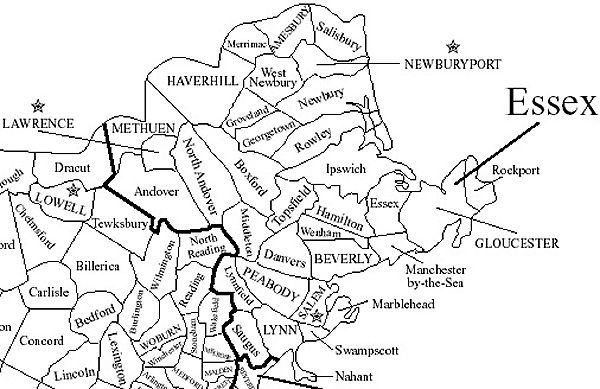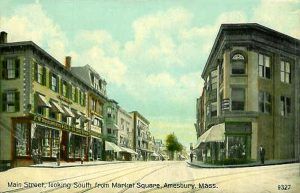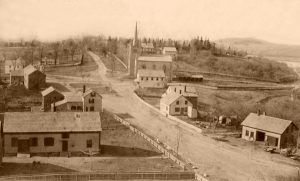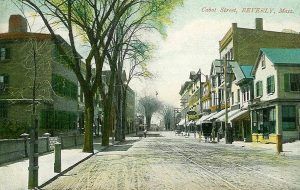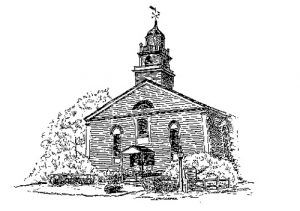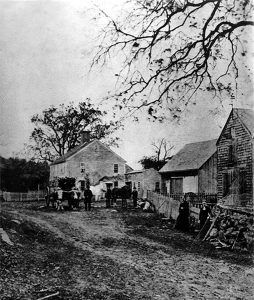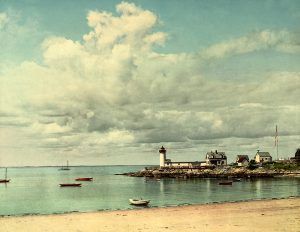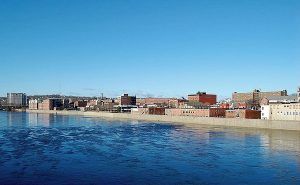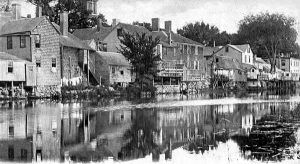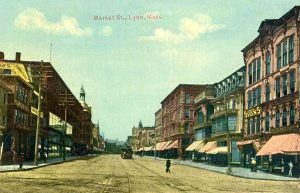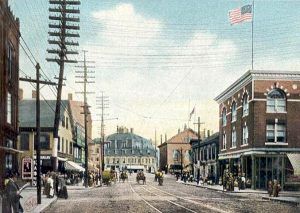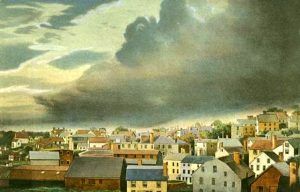Peabody (part of Salem in 1692)
Salem Village (now called Danvers)
Though the Salem witch trials began in Salem Village, it was certainly not the only village involved in the hysteria of 1692. Because Salem Village was, at that time, a parish of Salem Towne and lacked its own government, most of the legal businesses, including the executions, were held in the larger city of Salem. These two communities are the most recognized in the Salem witch trials’ hysteria; however, several other towns in Essex County also experienced witchcraft allegations and initial examinations of the accused. Some of these communities included nearby Andover, which produced most of witchcraft accusations and trials; Ipswich, Beverly, Haverhill, Topsfield, Gloucester, and many others.
While these were not the first examples of executions for witchcraft in New England, the volume of accusations and convictions generated one of the most infamous examples of mass hysteria in American History.
Amesbury – Situated in Essex County, Amesbury was settled in 1655 as a part of the village of Salisbury. However, it was separated from Salisbury in 1666 and incorporated as the town of Amesbury in 1668. It began as a modest farming community and later developed an aggressive maritime and industrial economy. The 90-foot drop in the falls of the Powwow River provided water power for sawmills and gristmills. Shipbuilding, shipping, and fishing were also important. The ferry across the Merrimack River to Newburyport was a lively business until the construction of bridges to Deer Island.
During the Salem witch trials of 1692, Amesbury had only one person accused, Susannah North Martin. Unfortunately, the 71-year-old impoverished widow was hanged on July 19, 1692.
Today, Amesbury is mainly residential and is home to more than 16,000 people.
Andover – Located about 15 miles northwest of Salem Village, Andover started when a portion of land was set aside for an inland plantation in 1634. During the Salem witch trials of 1692, Andover, like other area villages, found itself amid the hysteria. More people from Andover were accused and arrested for witchcraft than any other town in New England. Before the hysteria in Andover ended, 80% of the town’s residents had been drawn into the witch hunt. Andover also holds the dubious distinction of having the most confessed witches and the highest number of children arrested. See the Full Article HERE.
Beverly – Situated in Essex County, Beverly was originally part of Salem Towne and the Naumkeag Territory. However, due to religious differences with Governor John Endicott, Beverly was separated from the larger city and officially incorporated in 1668. It was named after the town of Beverley in Yorkshire, England. In 1671, Roger Conant, with 34 others, petitioned that the name be changed to Budleigh, the name of the city in England where he was born. He said they should accept his petition because he was such an important founder of Beverly and had never petitioned for anything else. But his petition was, obviously, denied. In 1675, King Philip’s War erupted, in which the Indians tried to eliminate the white settlers. Many of Beverly’s men fought in this war.
During the Salem witch trials of 1692, Beverly, like many other area villages, played a role. The pastor of the Church of Christ in Beverly, Massachusetts, the Reverend John Hale, was one of the most prominent and influential clergymen associated with the witch trials. Initially, he supported the trials until his wife, Sarah Noyes Hale, was accused. He then changed his mind and later published a critique of the whole affair. Though his wife was accused, she was never charged. However, this would not be the case for several other Beverly residents. Dorcas Galley Hoar, a widow in her late fifties, was known to have practiced fortunetelling and had long been suspected of being a witch. It comes as no surprise that she was the first to be accused in Beverly. At her trial, she was found guilty and condemned to hang. However, she then confessed and, with the support of several ministers, was given a reprieve and released. Also accused were Sarah Murrell, Sarah Morey, Sarah Riste, Susanna Rootes, and Job Tookey. Almost all of Beverly’s accusations were made from the end of April to June 1.
Today, Beverly is a community of almost 40,000 people. The Reverend John Hale’s house, built in 1694, still stands at 39 Hale Street and is open to the public. His body is buried at the Ancient Burial Ground between Hale and Abbott Streets.
Billerica – Situated in Middlesex County, the settlement was an Indian village named Shawshin when European settlers first visited the site. In 1638, Massachusetts Bay Governor John Winthrop and Lieutenant Governor Thomas Dudley were granted land along the Concord River, and a settlement was formed. Under the supervision of the City of Cambridge, financial difficulties prevented the village from being settled immediately. Finally, in 1652, roughly a dozen families from Cambridge and Charlestown Village began to occupy Shawshin, and later more families from Woburn would join them. Wishing to replace the foreign-sounding Shawshin with a more familiar name, the settlers chose the name Billerica because many of the families had come from there. The town was incorporated in 1655.
During the witch trial frenzy of Salem Village, Billerica, which is situated about 20 miles west of Salem Village, soon found many of its citizens accused. Dr. Roger and Mary Allen Toothaker would be accused by their niece, Sarah Carrier of Andover. Their daughters, ten-year-old Margaret and Martha Toothaker Emerson of Haverhill were also accused. Although there is no testimony to such, many believe that John Durrant and Rebecca Chamberlain were also victims of the Salem witch hunts. Both died in prison in Cambridge, John Durrant in October 1692 and Rebecca Chamberlain in September 1692. Other Billerica residents were summoned to testify as witnesses, including John Rogers, who had once been a close neighbor to Thomas and Martha Carrier, and Captain Jonathan Danforth. Though John Rogers agreed to attend, Captain Danforth refused, stating that he had nothing to say.
Today, the population of Billerica is about 40,000 people.
Boxford – Located in Essex County, Boxford was first settled in 1646 as part of Rowley Village by Abraham Redington. It was officially incorporated in 1685, when about 40 families resided in the settlement. The primary occupation of early settlers was farming, though there were several craftsmen located in the village. Boxford did not gain its own church until 1701, so its residents likely attended church in other nearby villages. During the infamous witch trials of 1692, three Boxford residents were accused of witchcraft. Rebecca Blake Eames was the first accused in August. She and her husband, Robert, lived near the Andover line with their son and his family.
She was examined on August 19, 1692, along with Mary Lacey, Sr., of Andover, who testified that Rebecca Blake Eames had baptized her son, Daniel Eames, as a witch. Confessing, Rebecca claimed that the Devil had bewitched her in the hollow through which Ipswich Road runs. She would also say that her son, Daniel Eames, was also a witch. On September 17, 1692, she and nine others were condemned to die. She would be imprisoned until May 1693, when she was finally released. Her son, Daniel, was also imprisoned for a time, but the results are unknown. Boxford’s only other case was when Hannah Post, the sister of Mary Post of Andover, who had been found guilty and condemned of witchcraft, was also examined and indicted. She was later found not guilty and released.
Boxford is now called home to about 8,000 people
Gloucester – Located on Cape Ann in Essex County, Gloucester was founded at Cape Ann by an expedition called the “Dorchester Company” of men from Dorchester, England, chartered by King James I in 1623. It was one of the first English settlements in what would become the Massachusetts Bay Colony and predated both Salem and Boston. The first company of pioneers made a landing at Half Moon Beach and settled nearby. However, life in this first settlement was harsh and short-lived. Around 1626, it was abandoned, and the people moved to Naumkeag, later called Salem. Even the meetinghouse was disassembled and relocated. However, the original location was slowly resettled over the years, and Gloucester was formally incorporated in 1642. It took its name from the city of Gloucester in southwest England.
When the infamous witch trials began in 1692, Gloucester was still an isolated farming community, not yet the thriving port and fishing town it would soon become. Like Salem Village, Gloucester had gone through several factional conflicts earlier in the century but, by 1692, mainly had obtained the stable, harmonious environment that Puritans expected of their communities. However, this model Puritan community produced 17 witchcraft accusations, more than most area villages, except Andover, Salem Village, and Salem Towne.
Though most of the community’s problems had resolved themselves, there was some remaining friction, as most of those accused were of high social and economic status, leading to the belief that there was envy on the part of some villagers. The remaining accused were known to have reputations as trouble-makers or were related to other accused witches.
The first Gloucester residents accused of witchcraft were Margaret Skillings Prince and Elizabeth Dicer on September 3, 1692. Ebenezer Babson accused them after he had asked some of the afflicted Salem Village girls to visit his mother, Eleanor, who was complaining of spectral visions of Indians and French soldiers. Ironically, the previous summer, Ebenezer Babson had been involved in an odd hysteria over phantom Indians and French soldiers that had allegedly gripped Gloucester. Despite this strange history, after the “afflicted girls” pinpointed Margaret Skillings Prince and Elizabeth Dicer, a complaint was sworn out against the two women. Around the same time, four more women were accused, including Mary Prince Rowe, Phoebe Day, Rachel Vinson, and Joan Penney.
Shortly afterward, James Stevens, a local church deacon and lieutenant in the militia, sent for the “afflicted girls” of Salem Village to name the witch he believed was afflicting his sister Mary Fitch, much like Joseph Ballard had done in Andover in September. When Mary Fitch, who was deathly ill, was visited by the “afflicted girls,” they named Rebecca Dike, Esther Elwell, and 15-year-old Abigail Rowe as the witches who had caused her illness.
Others accused of witchcraft in Gloucester included William Brown, Ann Higginson Dolliver, Joseph Emons, and Abigail Somes. Four more women who were accused successfully fought back by filing a legal action for slander against those who were spreading rumors about them. These women included Agnes Evans, Grace Dutch, Elizabeth Perkins, and Sarah Vinson. Fortunately for the accused, it appears that these cases never went to trial because the use of spectral evidence was banned in October 1692, giving prosecutors little evidence to go on, and the Court of Oyer and Terminer was disbanded. Public officials set up the Superior Court of Judicature in November to hear the remaining witchcraft cases. Between January and May of 1693, most accused were released due to a lack of evidence or tried and found not guilty.
Today, Gloucester is an important center of the fishing industry and a popular summer destination. It’s called home to a population of almost 29,000 people.
Haverhill – Located about 24 miles north of Salem, on the Merrimack River, Haverhill started as a farming community, founded in 1640 by settlers from Newbury. It was initially known as Pentucket, a Native American word for “place of the winding river.” It was later renamed for the town of Haverhill, England, in deference to the birthplace of the settlement’s first pastor, Reverend John Ward. Haverhill has played a role in nearly every era of American history, from the initial colonial settlement to the French and Indian Wars and the American Revolution and Civil War. It also played a role in the infamous Salem witch trials of 1692.
When the hysteria began, Haverhill resident, Judge Nathaniel Saltonstall, was chosen to preside over the Salem witch trials; however, he found the trials objectionable and recused himself. Some historians cite his reluctance to participate in the trials as one of the reasons that the witch hysteria did not take as deep a root in Haverhill as it did in the neighboring town of Andover, which had the most witch hunt victims. However, several women from Haverhill were accused of witchcraft, and a few were found “guilty” by the Court of Oyer and Terminer. In the old Pentucker Cemetery, located at the intersection of Water and Mill Streets, lies the remains of Major Nathaniel Saltonstall, who objected to the witch trials.
Today, Haverhill is called home to almost 61,000 people.
Ipswich – A coastal town in Essex County, Ipswich was founded by John Winthrop the Younger, son of John Winthrop, one of the founders of Massachusetts Bay Colony in 1630 and its first governor, elected in England in 1629. When the colonists first arrived, they investigated the region of Salem, Massachusetts, and Cape Ann, including a place they called Agawam. However, they settled in Charlestown. In 1633, John the Younger decided to settle at Agawam. He and 12 men soon sailed into Ipswich harbor and took up residence there. The following year, the town was incorporated and called Ipswich, after a town in Suffolk County, England. Nathaniel Ward, an assistant pastor in town from 1634 to 1636, wrote Massachusetts’s first code of laws. Early settlers became farmers, fishermen, shipbuilders, and traders.
Like other local villages, Ipswich would see some of its citizens arrested for witchcraft, but the hysteria that took over other nearby settlements, such as Salem Village and Andover, would not have the same impact in Ipswich. This is accredited to the ministers of the settlement who put themselves on record as not being in agreement with the delusion of the witch trials.
However, Rachel Clinton was arrested for witchcraft at the end of March 1692. She was indicted and imprisoned until 1693. Destitute, she would die just two years later. It probably came as no surprise to area residents that Mehittable Braybrook Downing, who had quite a questionable history and reputation for the time, was also arrested and imprisoned. Also accused were Thomas Dyer, Anna Edmunds, Margaret Read, and Thomas Wells. No one from Ipswich was executed. Sarah Buckley, the wife of William Buckley, who was a former resident of Ipswich, was also accused, but the Reverend William Hubbard stepped up to save her.
Today, Ipswich is a residential community with a vibrant tourism industry. It is called home to about 13,000 people.
Lynn – Located in Essex County, Lynn was first settled in 1629 by Edmund Ingalls, who was followed by a number of other settlers who wanted to find a less crowded area. They bargained with the Nipmuck Indians for some land known as Saugus, and in 1631 the settlement was incorporated as Saugus. The land originally purchased from the Indians now encompasses not only the city of Lynn but also Reading, Swampscott, Nahant, Saugus, and Lynnfield. In 1637, the settlement’s first official minister, Samuel Whiting, arrived from King’s Lynn, England. The settlers were so excited that they changed the name of their community to Lynn in honor of him. Although mostly an agricultural community, early settlers also relied on shellfishing, and many were skilled in making leather shoes, resulting in the first tannery in the United States being established in Lynn in 1629.
Lynn had its first “witch scare” in 1669 when Ann Holland Basset Burt, a Quaker, and a midwife, was brought up on charges of witchcraft. Because she was not a doctor but was successful at curing the sick, some people felt she could only have medical skills if she were a witch. Apparently, no action was taken against Ann Burt as a result of these charges. However, some of her descendants would not be so lucky. Her granddaughter, Elizabeth Bassett Proctor, of Peabody, Massachusetts, would be accused of witchcraft, found guilty, and condemned to die. She was only spared because she was pregnant. Her husband, John Proctor, would be hanged for wizardry. Several more in the family would also be accused.
During the witch hysteria, there were a number of people from Lynn who were accused of witchcraft, including Sarah Hood Bassett, Sarah Aslett Cole, Jane Greepe Collins, Thomas Farrar, Margaret Gifford, Elizabeth Huthinson Hart, and Mary Leach Ireson.
Today, Lynn is the largest city in Essex County. It is an urban manufacturing and commercial center, densely populated and culturally diverse. Residents are proud of the city’s long history, which parallels the history of New England as a whole. It is called home to more than 90,000 residents.
Malden – Situated in a hilly woodland area north of the Mystic River in Middlesex County, Malden is about 16 miles southwest of what was once called Salem Village. It was settled by Puritans in 1640 on land purchased in 1629 from the Pennacook Indian tribe. The area was originally called the “Mistick Side” and was a part of Charlestown. It was incorporated as a separate town in May 1649. The name Malden was selected by Joseph Hills, an early settler and landholder, and was named after a small parish in Surrey County, England. That same Joseph Hills compiled the first code of enacted laws printed in New England in 1648. A church was organized in 1649, but the date of the erection of the first meeting house is not known. Among the early ministers was the Reverend Michael Wigglesworth, a poet as well as a preacher, who was ordained in 1656 and continued as pastor until his death on June 10, 1705. Malden originally included what are now the adjacent cities of Melrose (until 1850) and Everett (until 1870).
During the witch hunts of 1692, several Malden residents were accused, including Mary Cox, Elizabeth Betts Fosdic, and Elizabeth Carrington Paine. The influential Captain John Floyd, who lived in Chelsea at the time of his accusation, had earlier lived in Malden.
Today, Malden is a large and prosperous town situated just four miles north of Boston. It is called home to more than 59,000 people.
Marblehead – Located in Essex County, Marblehead was first settled as a plantation of Salem in 1629 by John Peach, Sr. At that time, the area was inhabited by the Naumkeag tribe; but smallpox epidemics in 1615–1619 and 1633 devastated the tribe. What was left of the tribe would later sell 3,700 acres to area residents in 1684. Over the years, more and more people migrated from nearby Salem, often to escape the strict discipline of the intensely religious Puritans. These people co-existed peacefully with the Naumkeag tribe. Twenty years after John Peach, Sr. had settled his plantation, enough people had come to the area that a town was incorporated in 1649. It was first called Massebequash after the river, which ran between it and Salem. It was also referred to as Marvell Head and Marble Harbor.
Later, the town’s name was changed to Marblehead by settlers who mistook its granite ledges for marble. The town prospered as a fishing village with narrow, crooked streets, gradually growing inland from the harbor. In fact, the fisherman did so well, that more people, hearing of the abundant fish, began to arrive from England to settle in Marblehead. On December 12, 1648, members of a Salem Towne Meeting voted, subject to the approval of the Massachusetts General Court, to grant Marblehead its complete independence from Salem.
Two years later, Marblehead would deal with its first official witch accusation. In 1650, a fisherman named Peter Pittford claimed that he had seen the “Goodwife James” step aboard a boat and put to sea “in the likeness of a cat!” He also insisted that she employed her evil talents to ruin his corn and beans. Jane James was the wife of a ship carpenter, who had, years earlier in 1639, been convicted of stealing. This created, for her, a bad reputation, and she soon became the target of numerous rumors. By 1650, neighbors began to cast her in the role of a witch. That year, as well as the next – 1651, and again in 1667, formal complaints would be made that James was a witch. Though she was never convicted, and all three times, won lawsuits against her accusers for slander, her reputation in the “court of public opinion” was forever ruined.
The next person accused of witchcraft in Marblehead would not be so lucky. Marblehead’s sole victim during the witch hysteria of 1692 was Wilmot Redd, the wife of a fisherman who was known for her bad temper and many disputes with her neighbors. She was accused by several of the “afflicted girls” of Salem Village, a warrant was issued for her arrest in May 1692, and she was examined in Salem Village. Several months later, in September, she was tried, found guilty, and sentenced to be hanged. Her execution was carried out on September 22, 1692. Years later, Marblehead would be known for another celebrity “witch” — Moll Pitcher. Though she never claimed to be a “witch,” many thought of her as such. She was actually a sought-after fortune-teller who was thought to have been very accurate, so much so that some sailors would not set foot on their vessels if she predicted any bad luck. Had she been “practicing” her skill a century earlier, she probably would have been hanged.
Today, Marblehead displays much of its early architecture from its heydays as a commercial fishing era. It is called home to almost 20,000 people. Several sites from the witch hysteria of 1692 can be seen. Redd’s Pond, located at the intersection of Pond and Norman Streets, is named for Wilmot Redd, who was one of the many executed during the infamous witch trials. Her home once stood near here. Adjacent to Redd’s Pond is the Old Burial Hill, founded in 1638. Though Wilmot Redd was not buried here as the law would not allow her to be buried in consecrated ground, she was probably buried in an unmarked grave near her home. Today, however, a memorial marker now stands next to her husband’s grave in Old Burial Hill. The historic cemetery also features numerous other historic Puritan gravestones. It is located on the high ground between Marblehead’s colonial-era residential and retail district, called “Old Town,” and the Barnegat neighborhood that stretches from Little Harbor to Doliber’s Cove. It is accessible via a walkway at Redd’s Pond and a stairway at the intersection of Orne and Pond Streets.
Also still standing in Marblehead is the Ambrose Gale House, built about 1663. Ambrose Gale is known for his testimony against Wilmot Redd, who would later be hanged for witchcraft. The privately-owned house is located at 17 Franklin Street, between Washington and Selman Streets.
© Kathy Alexander/Legends of America, updated June 2023.
Also See:
The Salem Witchcraft Hysteria (main article)

